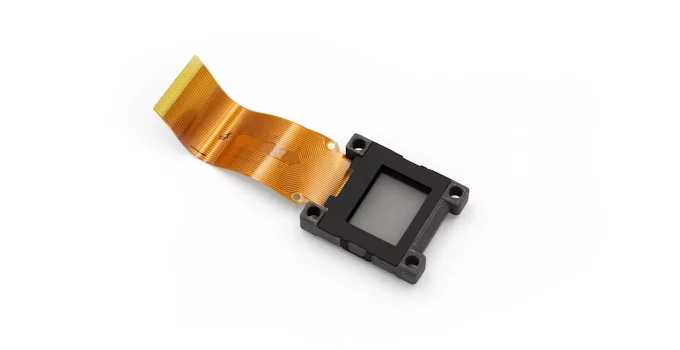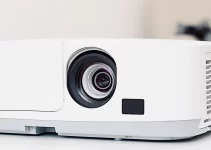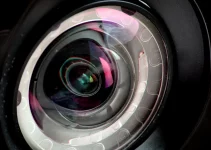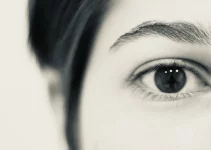Let’s make things easier right from the start of this DLP vs LCD vs LED projectors comparison: DLP/LCD are chip technologies used for creating the displayed image, while LED projector are called that because they’re using a light-emitting diode as light source.
They’re completely different things but they also have in common the fact that LED projectors can be either DLP or LCD. As far as I am aware, at the moment, the majority of LEDs are DLP.
Table of Contents
DLP vs LCD vs LED Projectors: Chip Technology vs Light Source
DLP and LCD are chip technologies that contribute to the image created by a projector on the screen/wall.
The third chip technology, which is not as popular as these two, is LCoS (Liquid Crystal Technology on Silicon). They’re also really expensive and only Canon, Sony and JVC have a few models.
Projectors that use either DLP or LCD chips can be: lamp-based, LED or laser.
Therefore, DLP & LCD are chip technologies that can be used by all three major types of projectors. Lamp-based differentiate themselves from LED and laser by the source of light.
For lamp-based we have HIDs (high intensity discharge) lamp as a light source. For LEDs we have light-emitting diodes as a light source. And for laser models we have a long-lasting semiconductor laser that is used as a light source.
Both laser and LED models have long lamp lives usually 20,000 hours on average. There will be models that will boast of up to 30,000 hours lamp life. Basically, you can use them for at least 10-12 years without noticing any decrease in brightness.
The other thing that differentiates them from lamp-based projectors is that there’s no lamp to be changed after a few years. That allows manufacturers to claim that LED and laser devices are basically maintenance-free. That’s what makes them increasingly more advantageous for some consumers.
DLP vs LCD vs LED Projectors: What Are They?
For the time being, the very important fact is that lamp-based models are a lot more popular than LED. It’s to be expected since these were the first on the market and technology has evolved impressively since the 80s when they were developed.
Moreover, the variety with lamp-based projectors is truly impressive, this is their winning point and why they’re still the most popular at the moment.
We get a variety of uses (business, education, house of worship, home theater), prices, resolutions, lamp life, brightness, contrast ratio, color gamut, connections (some are wireless, some have Bluetooth), some have speaker(s), a few are short-throw or ultra short-throw, etc.
There are just more DLP and LCD lamp-based models than there are LEDs. Moreover, out of the three, LCD projectors tend to deliver the best image quality, in my opinion.
Nowadays, you’ll even find DLP/LCD/3LCD laser projectors. Thus, DLP and LCD also transcends to laser models. Moreover, Optoma uses the DLP display technology for their LED models.
DLP-chip technology
DLP stands for Digital Light Processing.
It’s a chip that is composed of microscopic mirrors and a spinning color wheel to generate images.
The microscopic mirrors reflect light toward a screen. The spinning color wheel is full of color filters used to generate sequential colors.
They can be single chip or 3-chip with an individual chip for red, green and blue. The 3-chip models are more high-end and not geared towards household consumers.
Some of the most popular manufacturers of DLP projectors are, among others, Optoma, BenQ, and Mitsubishi. Optoma uses DLP for their LED and laser models, too.
DLP lamp-based projectors certainly used to be very popular but, since Epson launched its first LCD projector in the late 80s, the DLPs have come to be regarded as less superior.
I think that, if the manufacturer uses high-end specs, either DLP or LCD models can be fantastic and highly praised.
Rainbow effect

It’s practically impossible to be talking about DLP and not mention the rainbow effect. I will admit that the technology has evolved. When we’re talking about the rainbow effect nowadays is not as serious as it used to be. However, that’s true if the manufacturer uses lens of high quality and a high spinning color wheel.
The rainbow effect results from the fact that single DLP-chip models use a color wheel. At any given fraction of a second a single color is displayed on the screen. Our brain combines it into a full color image because it’s done really fast.
However, some people’s brains will register the sequential color, making it look like a rainbow smear, becoming more noticeable if you move your eyes rapidly around the screen.
Some are bothered by it while others don’t care. There are also those who don’t see RBE at all.
Just as the name suggests, the rainbow effect can also be noticed when bright objects on a dark background appear to have trails of multicolored light.
High-end models won’t suffer from this effect (3-chip DLP) but cheaper models might exhibit it.
Nevertheless, when it comes to motion blur, we could say that DLP is the winner over LCD because it offers sharper and more detailed images during fast motion scenes. Some might not even notice this aspect but others will.
On the other hand, it is considered that LCD models have better contrast ratio and color saturation.
The Most Popular DLP manufacturer
One major, popular manufacturer that focuses its efforts on DLP chips is Optoma. I think this is the number one seller of DLP projectors.
I will be the first to admit that some LCD-chip projectors are superior to DLP-chips but I have to give them a major credit: some of their prices are unbeatable. Plus, there are a lot of models to choose from.
Optoma is the best example that their range can be just as wide: they have lamp-based, LED, and laser projectors. All with DLP chips.
They have models with resolution from SVGA to Full HD 3D and 4K. they serve businesses, education applications, and entertainment purposes.
Their models are overall affordable but they still offer bright images, wide color gamut, and multiple connectivity options.
For example, if you want to buy a Full HD laser DLP projector, Optoma really has the best price. I’m talking about the Optoma HZ39HDR, which I also reviewed in my post on the best projectors for daylight.
LCD-chip technology
LCD stands for Liquid Crystal Displays.
You might know about this technology from TVs. The technology is similar. As the name suggests, liquid crystal displays are used to generate images, rather than physical moving parts as in DLP chips.
Different sets of lens, mirrors and color filters are used to display the final image.
When it comes to LCD technology, you’ll come across 3LCD, which as you’ve probably guessed, is the more advanced form.
3LCD gets its name because it has 3 chips or it’s 3-chip. You can get 3LCD lamp-based or 3LCD laser projectors.
3LCD uses individual LCDs for red, green, and blue. That’s why it’s 3 of them. The 3 of them use a prism to create the final image.
It’s obviously better than a single chip LCD or DLP.
With laser, the 3LCD chips are used if the manufacturer wants to avoid making any compromises between high brightness and high resolution. If they want to deliver, let’s say, a brightness of 7,000 lumens and a beautiful high resolution of WUXGA (1920 X 1200 pixels). But such models don’t come cheap at all.
The Most Popular LCD manufacturer
Epson remains the most popular manufacturer of LCD projectors, having a wide variety of models to suit different budgets and uses. It can also be considered the largest manufacturer of projectors in the world.
We can give countless examples but a favorite of mine is the Epson Home Cinema 1080 3LCD. This is a great model for entertainment use and it has a good enough brightness that it can be used for game days or for playing movies in daylight. It has awesome specs, Full HD resolution, and an affordable price.
On the pricier side, we have the Epson Home Cinema 3200, which is a 4K PRO-UHD 3LCD.
If you’re interested in a model just for education purposes, the Epson PowerLite L200SX is a XGA 3LCD laser.
On the other hand, the Epson Pro EX9210 is an affordable WUXGA business/education projector with a very high resolution and a decent price.
LED Projectors
LED models use light-emitting diodes as the source of light. Thus, they’re lampless, there are no components to replace.
With lamps, the light is created from a hot filament.
With light-emitting diodes, the light is created by corralling and manipulating electrons below the surface and forcing them to emit light at a specified frequency.
No maintenance
Their lifespan is estimated at about or over 20,000 hours. That can easily exceed 10 years of use, it really depends on how frequently you use your device.
Efficient
The models are also smaller and generate less heat. The cooler operating temperatures increase their efficiency, which might in turn make them require less power consumption.
To better understand why I say that they might require less power consumption, let me say this: LED projectors will have a brightness of 600-800 ANSI lumens on average, while 2,000 ANSI lumens can be considered the maximum brightness.
However, don’t misunderstand: they’re still regarded as being capable of delivering high quality images, even if their lumens volume is quite low.
That’s because LED models have managed to improve color saturation and higher luminous efficiency. They’re definitely focused on efficiency,. Which, I guess, could be the motto for all light-emitting diodes products.
Since they have so few lumens you can see why I say that they consume less watts, under 100W is common, than LCD and DLP lamp-based or laser, which will have an average power consumption of 200W–300W for Full HD and 300-400W for 4K.
Nevertheless, we must also remember that LEDs are not as bright as laser illumination.
ANSI lumens vs LED lumens
ANSI (American National Standard Institute ) lumens remains the international standard for measuring projector brightness.
If a manufacturer uses lux, LED lumens or light source lumens, then you should know that these are measurements that are not recognized by the international standard.
Understandably, some manufacturers have the desire to use LED lumens to indicate the brightness of their models because it just doesn’t sound as impressive when you say that your model has a brightness of 600 ANSI lumens when lamp-based models easily exceed 1,500/2,000/3,000 ANSI lumens.
LED-based light sources have a higher perceptible brightness than many lamp-based projectors, even when they use the same ANSI lumen rating.
Interesting LED projectors
Even if they sound really good on paper, it’s still pretty hard to find some really good models with high-end specs.
None of the big names, like Sony, Epson, Panasonic, etc. have gotten into this market, which definitely makes choices more limited.
LG is the manufacturer that stands out when it comes to LED devices. Their models are designed for portability, geared towards gaming and home entertainment with multiple connectivity options, a high resolution, and a very affordable price.
LG PF50KA
The first I want to quickly talk about is the LG PF50KA Full HD CineBeam LED projector because it has a pretty decent price for a device with a 1080p native resolution.
Being Full HD is a major point in its favor. Moreover, it has 600 lumens brightness and a power consumption of 65W.
It’s a small, portable model that has a built-in battery for up to 2.5 hours of video at up to 100 inches. It also features premium content with LG Smart TV platform built-in and wireless, USB-C, Bluetooth connectivity. The LED lamp has a life estimated at up to 30,000 hours. Overall, people are nicely satisfied with it and it’s a good model at a really affordable price.
Optoma ML750ST
A second model that is a very nice LED projector is the Optoma ML750ST. What I don’t necessarily like about this Optoma is that it’s slightly more expensive than the LG above, while it has a lower WXGA resolution (1280 x 800 pixels) and even a lower number of lumens, 450 lumens.
WXGA is mostly a resolution found in business/education projectors and it has a 16:10 aspect ratio but you can adjust this model for the 16:9 and 4:3 aspect ratios. You can use it for presentations or for watching movies at home.
Optoma describes it as an ultra-compact short throw model. You can project a 100 inches image from just over a meter away. It’s absolutely portable, weighs under 1 pound. It also features a media player, built-in speaker, native office viewer, microSD card slot, USB, and HDMI. You can also connect it wirelessly via the HDCast Pro app or wireless USB adapter (optional, not included).
ViewSonic and Asus are two other manufacturers that you can check out.
DLP vs LCD vs LED Projectors: Specs Comparison
In making a DLP vs LCD vs LED projectors comparison in terms of specs, we’re actually making a short comparison between lamp-based vs LED projectors.
Life span
In terms of life span, there’s really no comparison.
We get about 5,000/6,000/7,000 hours on normal mode with most lamp-based models. After that, the brightness decreases noticeably and we have to go for a replacement.
On the other hand, LEDs promise 20,000-30,000 hours of use without a noticeable decrease in quality. The same goes for lasers. That can amount to 8, 10 years or even more, depending on how much and how often you use it.
Price
Lamp-bases DLPs are usually the most affordable, the price is majorly influenced by resolution and lumens volume.
You can even find Full HD DLP laser models at a little more than $1,000.
LCDs are slightly more expensive. However, a good 3LCD Full HD Epson can be around $800, which is definitely affordable for the quality we get. You just have to take into account that you’ll have to change the lamp in a few years.
LED projectors aren’t too pricey in general. The few models that we have on the market focus on low prices, decent resolution, ultra-portability, nice brightness, and a multitude of connections. They’re quite easy to use. The prices for a decent model will be around $500-$700.
Because they offer ultra-portability and they also include a battery, LED models are also some of the best projectors for camping.
Rainbow effect
RBE is something to be expected with some single chip DLP lamp-based and laser projectors.
However, there’s one exception. You absolutely won’t get the rainbow effect with LED projectors because these have no need for a color wheel. The colors are produced natively.
You can see in these graphs here how each DLP projector works, whether it’s DLP lamp-based, laser or LED. In those graphs, you’ll notice that LED is the only type that doesn’t use a color wheel to produce an image.
In the end, this DLP vs LCD vs LED projectors comparison has once again reminded us that there’s more variety with lamp-based models both in terms of prices and quality, that LED projectors are perfect if you want portability and affordable prices, and that LCD projectors are still the ones that strike a very good balance between top-notch quality and prices.




